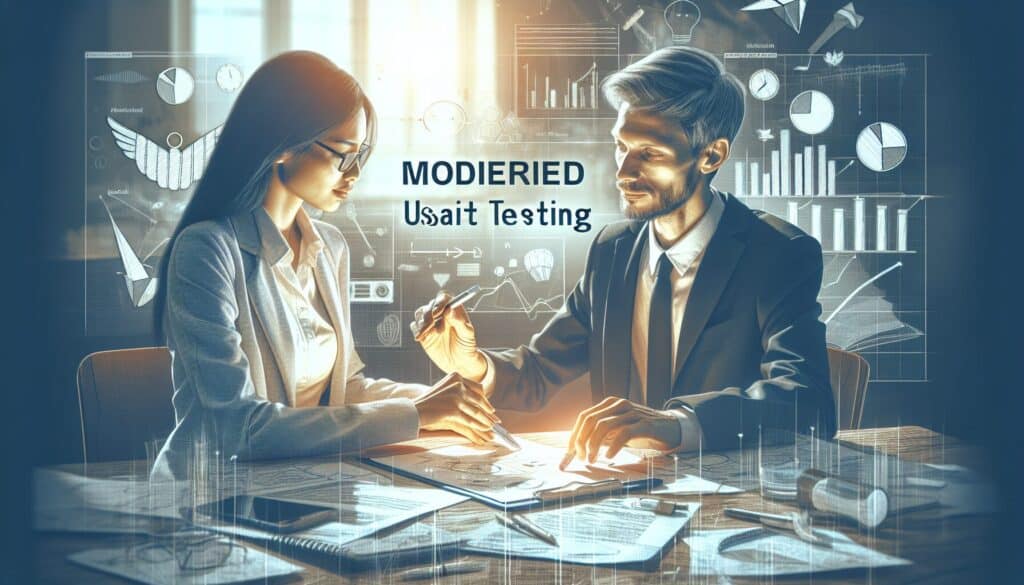A usability evaluation method where a trained moderator facilitates a session with a representative user who performs predefined tasks with a product or prototype, while the moderator observes, asks questions, and probes for insights.
- Methodologies: Engineering, Quality
Moderated Usability Testing (In-person or Remote)

Moderated Usability Testing (In-person or Remote)
- Design Evaluation, Design Thinking, Human-Computer Interaction, Usability, Usability Testing, User experience (UX), User Interface (UI), User Testing, User-Centered Design
Objective:
How it’s used:
- The moderator guides the participant through tasks, encourages them to think aloud, and asks follow-up questions to understand their behavior, thought processes, and any difficulties encountered. Sessions can be conducted in a lab (in-person) or online using screen-sharing and video conferencing tools (remote).
Pros
- Allows for deep qualitative insights and direct observation of user behavior; Moderator can clarify instructions and probe for understanding; Can uncover usability issues that users might not report otherwise; Flexible to adapt tasks or questions based on user interaction.
Cons
- Can be expensive and time-consuming per participant; Moderator presence might influence participant behavior (Hawthorne effect); Requires a skilled moderator to avoid leading participants; Scheduling can be challenging.
Categories:
- Customers & Marketing, Product Design, Quality
Best for:
- Gaining in-depth understanding of how users interact with a product, identifying specific usability problems, and gathering qualitative feedback on design solutions.
Moderated Usability Testing is particularly impactful in industries such as software development, consumer electronics, automotive design, and health tech, where understanding user interaction with products is paramount for successful outcomes. In the design and development phases of projects, this methodology is executed to iteratively refine products by involving participants who represent the target audience, enabling the collection of substantial qualitative data. Stakeholders such as UX designers, product managers, and engineers typically initiate this process, ensuring participants are briefed on objectives while also being encouraged to express their thoughts articulately. The environment can range from a controlled lab setting to flexible remote sessions, utilizing tools like Zoom or Microsoft Teams for effective communication. Feedback gathered can guide design iterations, revealing insights about user motivations, expectations, and pain points, which are often not apparent through surveys or analytics alone. The moderator’s capability to adapt questions in real-time based on participant reactions is invaluable for uncovering usability challenges that individuals may overlook in less interactive testing frameworks; as a result, this approach contributes to improved user satisfaction and product performance when applied effectively.
Key steps of this methodology
- Conduct a brief introduction to establish rapport with the participant.
- Introduce the task and explain the goals of the session.
- Instruct the participant to share their thoughts aloud while interacting with the product.
- Observe user interactions closely to identify any struggles or hesitations.
- Ask follow-up questions to clarify and probe into user behavior and thought processes.
- Monitor the time spent on each task, adjusting if necessary to maintain session flow.
- Encourage participants to express their emotions and feelings about their experiences.
- Introduce new tasks or variations if needed based on participant interactions.
- Conclude with a debriefing to discuss overall impressions and specific feedback.
Pro Tips
- Utilize user scenarios that reflect real-world contexts to ensure participants' feedback is grounded and relevant.
- Incorporate think-aloud protocols with clarifying prompts to elicit deeper cognitive insights into user decision-making processes.
- Implement a debriefing process immediately after sessions to capture fresh thoughts and sentiments about the usability experience.
To read and compare several methodologies, we recommend the
> Extensive Methodologies Repository <
together with the 400+ other methodologies.
Your comments on this methodology or additional info are welcome on the comment section below ↓ , so as any engineering-related ideas or links.
Historical Context
1986
(if date is unknown or not relevant, e.g. "fluid mechanics", a rounded estimation of its notable emergence is provided)

Related Posts
Master Production Schedule (MPS)
Mass Customization
Marketing Funnel
Marketing Audit
MAPO Index (Movement and Assistance of Hospital Patients)
Manufacturing Resource Planning (MRP II)